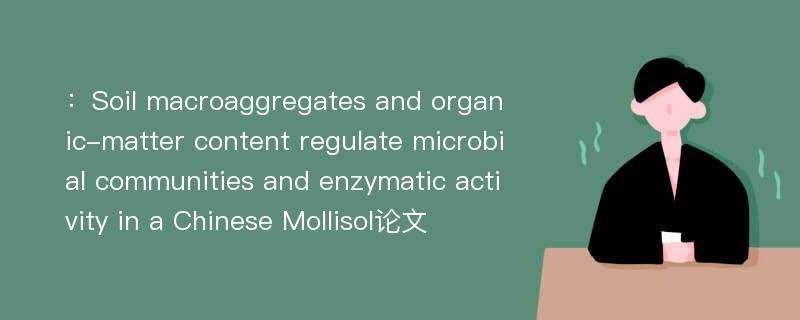
本文主要研究内容
作者(2019)在《Soil macroaggregates and organic-matter content regulate microbial communities and enzymatic activity in a Chinese Mollisol》一文中研究指出:The formation and turnover of macroaggregates are critical processes influencing the dynamics and stabilization of soil organic carbon(SOC). Soil aggregate size distribution is directly related to the makeup and activity of microbial communities. We incubated soils managed for >30 years as restored grassland(GL), farmland(FL) and bare fallow(BF) for 60 days using both intact and reduced aggregate size distributions(intact aggregate distribution(IAD)<6 mm; reduced aggregate distribution(RAD)<1 mm), in treatments with added glucose, alanine or inorganic N, to reveal activity and microbial community structure as a function of aggregate size and makeup. Over a 60-day incubation period, the highest phospholipid fatty acid(PLFA) abundance was on day 7 for bacteria and fungi, on day 15 for actinomycete. The majority of the variation in enzymatic activities was likely related to PLFA abundance. GL had higher microbial abundance and enzyme activity. Mechanically reducing macroaggregates(>0.25 mm) by 34.7% in GL soil with no substrate additions increased the abundance of PLFAs(average increase of 15.7%) and activities of β-glucosidase(increase of 17.4%) and N-acetyl-β-glucosaminidase(increase of 7.6%). The addition of C substrates increased PLFA abundance in FL and BF by averages of 18.8 and 33.4%, respectively, but not in GL soil. The results show that the effect of habitat destruction on microorganisms depends on the soil aggregates, due to a release of bioavailable C, and the addition of substrates for soils with limited nutrient availability. The protection of SOC is promoted by larger size soil aggregate structures that are important to different aggregate size classes in affecting soil C stabilization and microbial community structure and activity.
Abstract
The formation and turnover of macroaggregates are critical processes influencing the dynamics and stabilization of soil organic carbon(SOC). Soil aggregate size distribution is directly related to the makeup and activity of microbial communities. We incubated soils managed for >30 years as restored grassland(GL), farmland(FL) and bare fallow(BF) for 60 days using both intact and reduced aggregate size distributions(intact aggregate distribution(IAD)<6 mm; reduced aggregate distribution(RAD)<1 mm), in treatments with added glucose, alanine or inorganic N, to reveal activity and microbial community structure as a function of aggregate size and makeup. Over a 60-day incubation period, the highest phospholipid fatty acid(PLFA) abundance was on day 7 for bacteria and fungi, on day 15 for actinomycete. The majority of the variation in enzymatic activities was likely related to PLFA abundance. GL had higher microbial abundance and enzyme activity. Mechanically reducing macroaggregates(>0.25 mm) by 34.7% in GL soil with no substrate additions increased the abundance of PLFAs(average increase of 15.7%) and activities of β-glucosidase(increase of 17.4%) and N-acetyl-β-glucosaminidase(increase of 7.6%). The addition of C substrates increased PLFA abundance in FL and BF by averages of 18.8 and 33.4%, respectively, but not in GL soil. The results show that the effect of habitat destruction on microorganisms depends on the soil aggregates, due to a release of bioavailable C, and the addition of substrates for soils with limited nutrient availability. The protection of SOC is promoted by larger size soil aggregate structures that are important to different aggregate size classes in affecting soil C stabilization and microbial community structure and activity.
论文参考文献
论文详细介绍
论文作者分别是来自Journal of Integrative Agriculture的,发表于刊物Journal of Integrative Agriculture2019年11期论文,是一篇关于,Journal of Integrative Agriculture2019年11期论文的文章。本文可供学术参考使用,各位学者可以免费参考阅读下载,文章观点不代表本站观点,资料来自Journal of Integrative Agriculture2019年11期论文网站,若本站收录的文献无意侵犯了您的著作版权,请联系我们删除。
